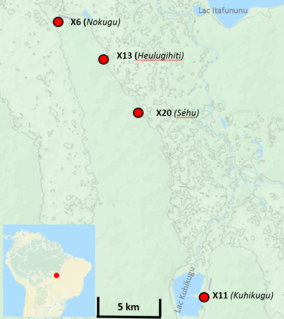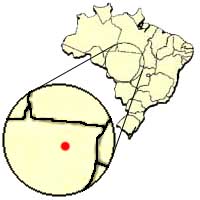
Shamanism is a religious practice that involves a practitioner (shaman) interacting with what they believe to be a spirit world through altered states of consciousness, such as trance. The goal of this is usually to direct spirits or spiritual energies into the physical world for the purpose of healing, divination, or to aid human beings in some other way.

The Xingu River is a 1,640 km (1,019 mi) river in north Brazil. It is a southeast tributary of the Amazon River and one of the largest clearwater rivers in the Amazon basin, accounting for about 5% of its water.

Indigenous peoples in Brazil or Indigenous Brazilians once comprised an estimated 2000 tribes and nations inhabiting what is now the country of Brazil, before European contact around 1500. Christopher Columbus thought he had reached the East Indies, but Portuguese Vasco da Gama had already reached India via the Indian Ocean route, when Brazil was colonized by Portugal. Nevertheless, the word índios ("Indians") was by then established to designate the people of the New World and continues to be used in the Portuguese language to designate these people, while a person from India is called indiano in order to distinguish the two.
The Tupi people were one of the most numerous peoples indigenous to Brazil, before colonisation. Scholars believe that while they first settled in the Amazon rainforest, from about 2,900 years ago the Tupi started to migrate southward and gradually occupied the Atlantic coast of Southeast Brazil.

The Cariban languages are a family of languages indigenous to northeastern South America. They are widespread across northernmost South America, from the mouth of the Amazon River to the Colombian Andes, and they are also spoken in small pockets of central Brazil. The languages of the Cariban family are relatively closely related. There are about three dozen, but most are spoken only by a few hundred people. Macushi is the only language among them with numerous speakers, estimated at 30,000. The Cariban family is well known among linguists partly because one language in the family—Hixkaryana—has a default word order of object–verb–subject. Previous to their discovery of this, linguists believed that this order did not exist in any spoken natural language.
Neoshamanism refers to new forms of shamanism. It usually means shamanism practiced by Western people as a type of New Age spirituality, without a connection to traditional shamanic societies. It is sometimes also used for modern shamanic rituals and practices which, although they have some connection to the traditional societies in which they originated, have been adapted somehow to modern circumstances. This can include "shamanic" rituals performed as an exhibition, either on stage or for shamanic tourism, as well as modern derivations of traditional systems that incorporate new technology and worldviews.

The Kamayurá are an indigenous tribe in the Amazonian Basin of Brazil. Their name is also spelled Kamayura and Kamaiurá; it means "a raised platform to keep meat, pots and pans." The Kamayurá language belongs to the Tupi–Guarani family.

Xingu peoples are indigenous peoples of Brazil living near the Xingu River. They have many cultural similarities despite their different ethnologies. Xingu people represent fifteen tribes and all four of Brazil's indigenous language groups, but they share similar belief systems, rituals and ceremonies.
The Panará are an Indigenous people of Mato Grosso in the Brazilian Amazon. They farm and are hunter-gatherers.
The Xingu Indigenous Park is an indigenous territory of Brazil, first created in 1961 as a national park in the state of Mato Grosso, Brazil. Its official purposes are to protect the environment and the several tribes of Xingu indigenous peoples in the area.
The Yawalapiti are an indigenous tribe in the Amazonian Basin of Brazil. The name is also spelled Iaualapiti in Portuguese. The current village Yawalapiti is situated more to the south, between the Tuatuari and Kuluene River. Their population in 2011 was 156, down from a 2010 population of 237 (2010) but up from a low of 25 in 1954.

Kuhikugu is an archaeological site located in Brazil, at the headwaters of the Xingu River, in the Amazon Rainforest. The area around Kuhikugu is located in part of the Xingu National Park today. Kuhikugu was first uncovered by anthropologist Michael Heckenberger, working alongside the local Kuikuro people, who are the likely descendants of the original inhabitants of Kuhikugu.
The Aweti people are a group of Native Americans living in the Xingu Indigenous Park, close to the headwaters of the Xingu River in Brazil. The Aweti inhabit two villages in the region. One is called Tazu’jyretam, and the other is unnamed. Tazu’jyretam is the main village of the Aweti people, and has been inhabited since at least the 19th century. Tazu’jyretam also has a small port. Both of these villages are located in an area between the Curisevo and Tuatuarí rivers, which feed into the Xingu further upstream. Their population was 196 in 2011, up from 140 in 2006.

The Kayabí or Kaiabi are an indigenous people of Brazil inhabiting the northern state of Mato Grosso. The primarily live in the Xingu Indigenous Park and the Indian Reservation of Apiaká-Kayabi south of Pará. There are approximately 1300 Kayabí living on the Xingu Indigenous Park. They are known by a number of names; Caiabi, Parua, Maquiri, Kawaiwete and many more romanizations of the word Kaiabi.

The Waura or Wauja (waujá) are an indigenous people of Brazil. Their language, Waura, is an Arawakan language. They live in the region near the Upper Xingu River, in the Xingu Indigenous Park, and had a population of 487 in 2010.
The Ikpeng are an indigenous community that now lives in the Xingu Indigenous Park in Mato Grosso, Brazil. They had a population of 459 in 2010, up from a low of 50 in 1969.
Amonap, also known as Apalakiri, is a Cariban language spoken by the Kuikuro and Kalapalo peoples of Brazil, and formerly by the Matipu. It is spoken in seven villages along the Culuene River in the Xingu Indigenous Park of Mato Grosso.
The Ikpeng language is the language of the Ikpeng people who live in the Xingu Indigenous National Park in Mato Grosso, Brazil. There are approximately 500 speakers. Ikpeng is a language with high transmission, meaning it is passed on from parent to child at a high rate, with all members speaking the language. The majority of members are also bilingual speakers of Portuguese. The Ikpeng language is part of the Carib (Karib) language family.
The Bakairi are an indigenous people of Brazil. They speak the Bakairi language, one of the Cariban languages. They call themselves Kurâ, Bakairi being a Portuguese term of unknown origin. They currently live in the Santana and Bakairi Indigenous Territories of northern Mato Grosso, in the municipality of Paranatinga in the northern cerrado south of the Amazon rain forest. Like most native peoples, they were more numerous before European contact. In 1999 there were about 950 Bakairi, of whom 898 lived in the two Indigenous Territories. In 1965 only 261 were recorded.
The Pekodian languages are a subgroup of the Cariban language family. The languages are spoken in Mato Grosso and Pará states of Brazil and make up the southernmost branch of Cariban.















